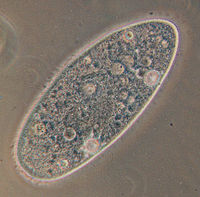Paramecium
| Paramecium | ||||||||||||
|---|---|---|---|---|---|---|---|---|---|---|---|---|
 Paramecium aurelia | ||||||||||||
| Scientific classification | ||||||||||||
|
Paramecium is a well-known genus of ciliate protozoa, commonly studied as a representative of that group. Paramecia are unicellular and slipper-shaped, ranging from 50 to 300 μm in length, depending on species. Simple cilia cover the body, and there is a deep oral groove, containing inconspicuous compound oral cilia, as found in other peniculids. Osmoregulation is carried out by a pair of contractile vacuoles, which actively expel water absorbed by osmosis from the surroundings. Paramecia are widespread in freshwater environments, and are especially common in scums. Paramecia are attracted by acidic conditions. Paramicia usually reproduce asexually, however, when food supplies are low, they may reproduce through a form of conjugation.
The division into species is still in flux—for instance, P. aurelia has recently been divided into 14 species—but the following are representative:
- P. aurelia Ehrenberg, 1838
- Paramecium bursaria (Ehrenberg) Focker, 1836
- P. calkinsi Woodruff, 1921
- P. caudatum Ehrenberg, 1838
- P. duboscqui Chatton and Brachon, 1933
- P. jenningsi Diller & Earl, 1958
- P. multimicronucleatum Powers & Mitchell, 1910
- P. nephridiatum von Gelei, 1925
- P. polycaryum Woodruff, 1923
- P. putrinum Claparede & Lachmann, 1858
- P. trichium Stokes, 1885
- P. woodruffi Wenrich, 1928
A number of doubtful species have also been recorded.
Paramecium in popular culture
- In a popular computer program, Chip's Challenge, the main character is chased by a cartoon paramecium, one of the many monsters that he must overcome.
Credits
New World Encyclopedia writers and editors rewrote and completed the Wikipedia article in accordance with New World Encyclopedia standards. This article abides by terms of the Creative Commons CC-by-sa 3.0 License (CC-by-sa), which may be used and disseminated with proper attribution. Credit is due under the terms of this license that can reference both the New World Encyclopedia contributors and the selfless volunteer contributors of the Wikimedia Foundation. To cite this article click here for a list of acceptable citing formats.The history of earlier contributions by wikipedians is accessible to researchers here:
The history of this article since it was imported to New World Encyclopedia:
Note: Some restrictions may apply to use of individual images which are separately licensed.